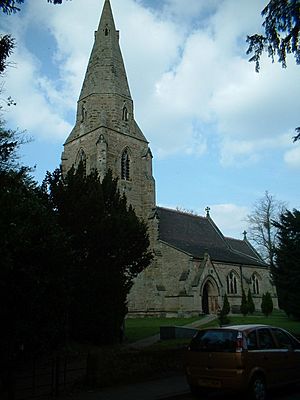All Saints' Church, Lullington facts for kids
All Saints' Church in Lullington, Derbyshire, is a very old and special church. It's a Grade II* listed building, which means it's an important historical place. It's part of the Church of England and serves the local community.
Quick facts for kids All Saints' Church, Lullington |
|
|---|---|

All Saints' Church, Lullington
|
|
| 52°42′49.74″N 1°37′54.53″W / 52.7138167°N 1.6318139°W | |
| Location | Lullington, Derbyshire |
| Country | England |
| Denomination | Church of England |
| History | |
| Dedication | All Saints |
| Architecture | |
| Heritage designation | Grade II* listed |
| Administration | |
| Parish | Lullington |
| Deanery | Repton |
| Archdeaconry | Derby |
| Diocese | Diocese of Derby |
| Province | Province of Canterbury |
Contents
A Look at All Saints' Church
This church is a very old and important building. It's officially known as All Saints’ Church, Lullington. It has a special status as a Grade II* listed building. This means it's a historically important place in Lullington, Derbyshire.
Church History and Age
The church building itself dates back to the 14th century. That's over 700 years ago! Imagine all the history it has seen. The tall, pointed roof part, called the spire, was rebuilt in 1776. People in the area even gave it a fun nickname: the Lullington Spud.
Big Changes in the 1860s
Between 1861 and 1862, the church got a big makeover. An architect named John West Hugall helped with the plans. A company called Elliott and Lilley did the building work. One of the main new parts was a south aisle, which is like an extra section on the side.
Inside, a gallery that used to block the tower was taken out. This opened up the space under the tower. The old seats in the main part of the church (the nave) and where the choir sits were replaced. The floor was covered with beautiful Minton tiles. The tiles in the special area near the altar had symbols on them.
The old altar slab was used to make a new reredos. A reredos is a decorated screen behind the altar. This one had a cross made of special marble and Derbyshire Blue John. It also had four smaller crosses. The font, which is a basin for baptisms, was made from granite. It stood on five marble pillars. All this restoration work cost about £2,000 back then. The church reopened on September 23, 1862.
The Church Organ
The church has an organ that was built by Halmshaw. It was put into the church in 1862, right after the big restoration. You can find more details about this organ on the National Pipe Organ Register.
Sharing a Parish
All Saints' Church is part of a "joint parish." This means it shares a priest and works together with several other churches in the area. These churches include:
- St Mary's Church, Coton in the Elms
- St John the Baptist's Church, Croxall cum Oakley
- St Nicholas and the Blessed Virgin Mary's Church, Croxall cum Oakley
- St Mary's Church, Rosliston
- St Peter's Church, Netherseal
- St Lawrence's Church, Walton-on-Trent
- St Matthew's Church, Overseal
More to Explore
- Grade II* listed buildings in South Derbyshire
- Listed buildings in Lullington, Derbyshire

